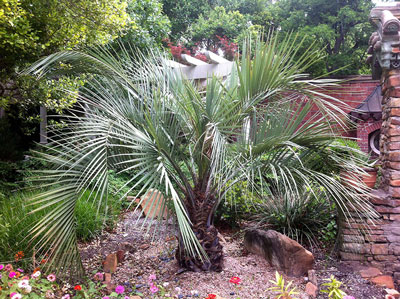From the Magazine: September 2014

This newly planted pindo palm provides an elegant and instant “fountain effect” in the garden. Photo by Steven L. Chamblee.
by Steven L. Chamblee
Tropical Beauty at Its Best
Pindo palm shimmers in summer — and survives the winter
Nothing says tropical like a palm, and nothing says it louder than a pindo. Pindo palm (Butia capitata) is the connoisseur’s choice among all of the cold-hardy palm species for Texas. Pindo is easily distinguished from the rest of the pack by its long pinnate leaves. (Pinnate leaves look like a large feather, as opposed to palmate leaves, where leaflets radiate out from one point, like fingers from your palm.) These arching, feather-like leaves emanate gracefully from the trunk, creating a dramatic, slate blue, fountain-like sculpture in the garden. It matures to about 15 feet tall and 10 feet wide, and there is simply no other cold-hardy plant like it for your Texas garden.
To fully appreciate the elegance of a pindo palm, you must give her some space. She is simply a center-stage plant. Her natural form is fully three-dimensional, with her 8-foot-long leaves spreading in all directions. Crowded among other shrubs or placed immediately in front of a tall hedge, the pindo becomes an indistinguishable mass of leaves. She is at her best when used as the center feature in the garden, surrounded by low-growing groundcovers, annuals, crushed stone, or even set as a lone specimen in a lawn. She is superb in a poolside garden, erupting out of a carpet of lantana, pentas, or periwinkle.
Pindo palm grows moderately fast, and on young plants, the older leaves will curl down and touch the ground. This detracts from the sculptural quality of the plant, so you will occasionally need to remove these leaves with a pruning saw. Removing even one or two of these large leaves can make a remarkable difference, so step back and check your work every few cuts.
Few insect or disease problems bother pindo palm, but root rot can occur in soggy soils. Make sure the planting area is elevated or well drained. Pindo palms require frequent watering immediately after planting, but are quite drought resistant once established.
Pindo palm also produces large clusters of inch-long, edible fruit that mature in mid-summer to a golden yellow color. These “pindo dates” can be eaten raw or pureed, but are typically made into jams and jellies, hinting at the plant’s other common name, jelly palm.
